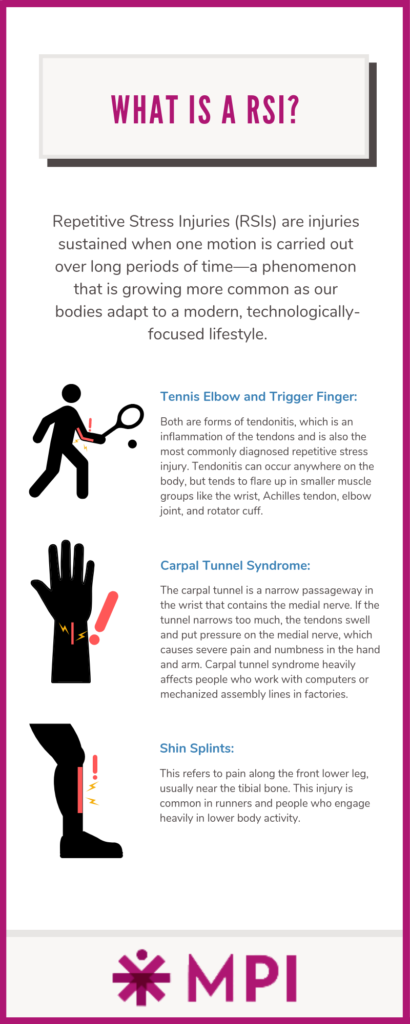Repetitive stress injuries, or RSIs, are relatively easy to diagnose, but individuals continue to suffer unnecessarily as their strains and aches go untreated. Becoming familiar with the common types of RSIs will help you ensure your body’s optimal functioning and long-term prosperity.
What is an RSI?
Repetitive stress injuries are injuries sustained when one motion is carried out over long periods of time—a phenomenon that is growing more common as our bodies adapt to a modern, technologically-focused lifestyle. Your body is obviously susceptible to injury, but the extent of the damage depends on various environmental factors, such as where you work, your activity level, and your amount of technology usage. Today, the main causes of RSIs are manual labor, office work, and the overuse of computers, leading to injuries localized in the upper body. In fact, nearly 2/3 of all occupational injuries are caused by repeated trauma or movement in the upper body, such as the shoulders, wrists, and elbows.
You may notice a continued throbbing sensation in muscles or joints that leads to swelling and restricted mobility. Other symptoms of an RSI include muscle weakness, numbness, or tingling in the affected joints. While repetitive stress injuries are caused by the overuse of a particular muscle group, it can be aggravated by certain other factors. Working in cold temperatures or with poorly designed (non-ergonomic) equipment, as well as engaging in taxing physical activities like high-level sports, tend to cause further discomfort.
Many commonly known conditions fit under the umbrella of RSIs. You may be familiar with some of these diagnoses:
- Tennis Elbow and Trigger Finger: Both are forms of tendonitis, which is an inflammation of the tendons, and they are the most commonly diagnosed repetitive stress injuries. Tendonitis can flare up anywhere in the body, but it most often occurs within smaller muscle groups, such as the wrist, Achilles tendon, elbow joint, and rotator cuff.
- Carpal Tunnel Syndrome: The carpal tunnel is a narrow passageway in the wrist that contains the medial nerve. If the tunnel narrows too much, the tendons swell and put pressure on the medial nerve, which causes severe pain and numbness in the hand and arm. Carpal tunnel syndrome heavily affects people who work with computers or mechanized assembly lines in factories.
- Shin Splints: This refers to pain along the front lower leg, usually near the tibial bone. This injury is common in runners and people who engage heavily in lower body activity.
Diagnosing Your RSI
RSIs fall into two categories: Type I and Type II. A Type I RSI refers to a musculoskeletal condition, the symptoms of which can be easily traced and diagnosed. Typically, these symptoms include the swelling and inflammation of specific muscles or tendons. Type II RSIs have a range of causes and therefore are difficult for physicians to precisely diagnose. Type II RSIs arise when symptoms are non-specific and are accompanied by a general feeling of pain.
Unlike many other disorders, repetitive stress injuries cannot be confirmed via testing. Instead, a doctor reaches a diagnosis via a series of questions, usually about lifestyle, so that the physician may determine the cause of the injury. The questions will be accompanied by a physical examination of the afflicted area to determine the scope of the issue. For certain types of RSIs, such as carpal tunnel syndrome, routine X-rays are run to reveal fractures or arthritis that may be causing further damage to nerves and tendons. More and more medical tables are being designed ergonomically with patient needs and limitations in mind, which is excellent for people who are dealing with a stress injury.
Treatment and Rehabilitation
Treatment for RSIs varies on a case by case basis, and the upside is that there are many options for people dealing with these kinds of injuries. There are simple techniques that you can use to address an RSI, such as taking frequent breaks while performing repetitive tasks, implementing stretching exercises, and altering your body position. Doctors may prescribe anti-inflammatory medication, or simply alternating ice and heat on the area until the pain subsides. Using the affected muscle less is recommended; however, this can be difficult if the motion causing the injury is work-related.
Sometimes treatment of the condition requires further attention and more nuanced care. After consulting your doctor, you may consider undergoing rehabilitation in order to improve your overall quality of life, strengthen your muscles, and reduce the risk of injury going forward. To achieve these goals, rehabilitation programs may include:
- Occupational therapy
- Exercise programs to strengthen the tissue
- Conditioning exercises to minimize future injury
- Braces or splints to immobilize the area during periods of intense pain
- Pain management techniques
Various health professionals can be involved in your rehabilitation, including sports medicine doctors, occupational medicine doctors, physical therapists, and occupational therapists. People also report that regular yoga practice, massages, and even acupuncture can relieve the symptoms of their stress injury.
A controversial aspect of RSI treatment is the use of steroid injections. These are commonly used for RSIs like tendonitis and carpal tunnel syndrome, but there is some contention in the medical field as to whether or not this is a sustainable practice. Cortisone shots are successful in reducing inflammation in inflammatory conditions such as arthritis, tendonitis, and bursitis, but they do not treat the underlying causes of the pain. Additionally, injected corticosteroids (cortisone) has been shown to weaken tendons over time, which could exacerbate problems for the muscles that are prone to injury. These injections are only recommended to reduce inflammation in an affected area caused by a definite condition like carpal tunnel syndrome. Occasionally, the use of steroids injected directly into certain tendons, like the Achilles tendon, can lead to traumatic rupture of the tendon.
In extreme cases, surgery may be considered the optimal treatment. It’s most commonly recommended in order to relieve the symptoms of carpal tunnel syndrome.
The cost of repetitive stress injuries can be minimized with the right diagnosis and treatment. Arm yourself with knowledge, and you can return to pain-free living in no time.


